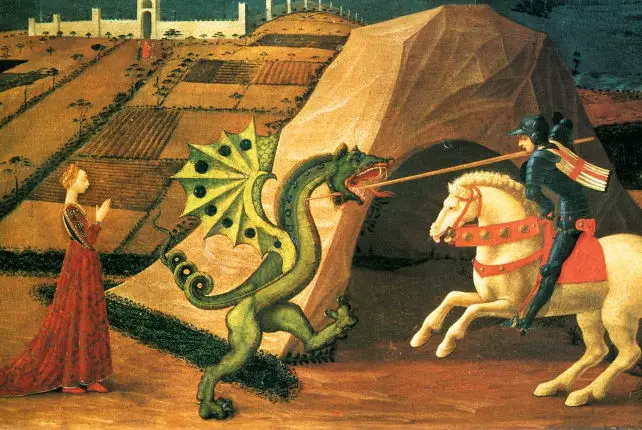Jonathan Dodd’s latest column. Guest opinion articles do not necessarily reflect the views of the publication. Ed
My neighbour, or rather someone I don’t know who lives over the road from me, has festooned his house with the English flag. That’s the one that’s white, with a red cross splitting it vertically and horizontally. Apparently, back in 1188, the kings of England and France agreed to go on a crusade together, and the French king decided he would like a red cross, and Henry II chose a white one. At some point these were swapped. Nobody knows when that happened.
This red cross is widely known as the Flag of St. George, who is always depicted as a knight, killing a dragon with his lance, and thereby saving the life of a princess. We’re not sure whether this person ever existed, or who the princess was, and we’re very sure that no such thing as a dragon ever existed. There was a George who worked for a Roman emperor and was said to have been killed because he became a Christian, but he was from the Middle East, and he was sainted for that, rather than for killing a dragon.
An amalgam of fantastical stories
The whole legend of Saint George appears to be an amalgam of fantastical stories. Everyone got in on the act, including the British, who decided that George visited Avalon, and the Swedes, who decided that the princess was in fact Swedish. Nowadays even the Catholic Church, who made the whole thing up in the first place, have decided that George probably wasn’t a proper saint, and he’s been downgraded. Nonetheless, in the meantime George was adopted as our patron saint, and he stuck somehow.

So we have a flag in his name and numerous other historical ideas and legends, and a general feeling that we would like to be brave like him, and maybe we’re attracted by the romance of killing a dragon or saving a princess, although that’s a story used by almost all the societies and civilisations that have ever existed. We like strength and bravery and confidence, and that’s why we adopted the lion as our national symbol, an animal that lives as far away from pour cool and damp shores as the legendary George. Curiously, we also adopted the Unicorn, another completely fabulous beast.
Appropriating symbols from elsewhere and making them our own
The medal we present for the highest acts of bravery by civilians is called the George Cross, and most people would think it was also in honour of George, but it was named after King George VI, who created it in 1940 as a civilian version of the Victoria Cross. We’re rather good in this country at appropriating symbols from elsewhere and making them our own, then using them for our own purposes. Or perhaps everyone in the world does that.
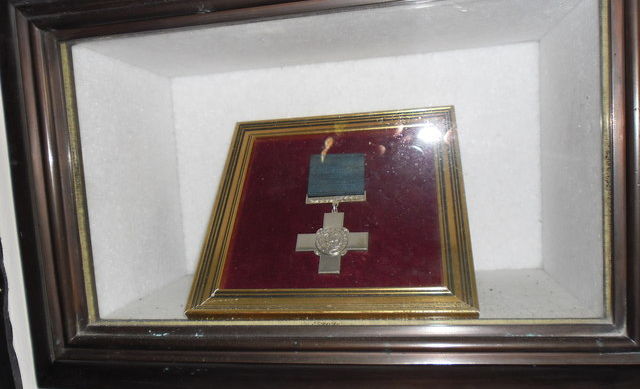
I do like the idea of finding examples of behaviour or character that we admire and attempting to emulate them. They become avatars of our aspirations in life, and we try, in our own way, to imitate them. Sometimes the imitation only takes the form of putting on a football shirt and shouting a lot while drinking vast amounts of beer, and sometimes it can be completely inspirational. I recently heard Professor Brian Cox speaking about his own decision to study science, based on his admiration for Stephen Hawking.
Symbolic of personal rectitude and dignity
I have two such heroes. The first one comes from a book and a film, called To Kill a Mockingbird. His name is Atticus Finch, and he was created by Harper Lee in her only published novel. There was another which she refused to publish, and they waited for her to die before cashing in and publishing it anyway. Atticus Finch is a lawyer in a small town in the Deep South of the USA in the 1950s. He is widowed, and he has two children. He defends a black man with only one functioning arm, who has been accused of rape by a somewhat hysterical white woman. The trial exposes all the fear and hatred of the white community, and the story was especially effective because it was told through the eyes of his young daughter, Scout.
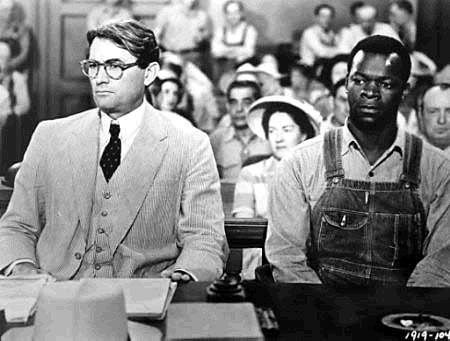
Atticus Finch became symbolic of personal rectitude and dignity, and a fierce desire to prevent injustice and defeat prejudice and ignorance and fear, by means of example rather than violence. He was a man portrayed as being modest and fair with a strong sense of responsibility and morality. There was a moment where the Sheriff arrived at his house to report that a rabid dog had been seen. Atticus was asked to shoot the dog, and Scout describes her astonishment at her father, who she had never seen with a rifle, calmly and expertly doing the deed and going back home. Being the best shot in the town wasn’t something he ever referred to or took pride in.
I just knew that I should try to be like him
When To Kill a Mockingbird was made into a wonderful black and white film in 1962, Gregory Peck took the part. He was already known for specialising in parts that were strong and moral, and he was an ideal choice. From the moment I saw him I just knew that I should try to be like him. It was an odd feeling, finding out that there was someone who personified all the things I instinctively felt to be right and proper, and to sum up so closely and clearly what a man should be, and how a man should behave.
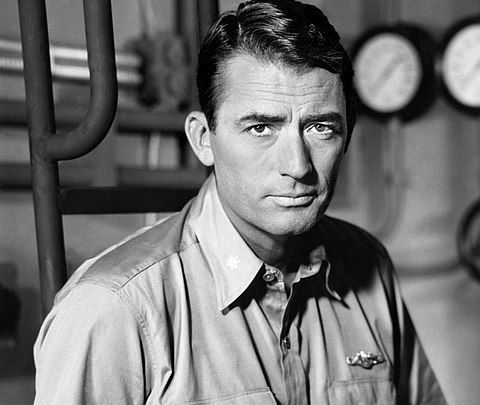
I do understand that Atticus Finch never existed, and that he was created by a great writer and played by a great actor in a great film, and that’s perhaps appropriate, because all of us ordinary humans are imperfect, and we all fall short of the standards that we struggle to live up to. Me especially. But I try.
Difficult and controversial subjects
My second personal hero has a lot of the qualities of Atticus, but he comes from a very different source. There’s a great Spanish director called Pedro Almodóvar, who writes and directs his own films. They’re very Spanish, and very outrageous, and often melodramatic and over the top, but his films are always striking and controversial, and they’re challenging. Almodóvar never misses an opportunity to push our thinking towards understanding and even accepting difficult and controversial subjects.
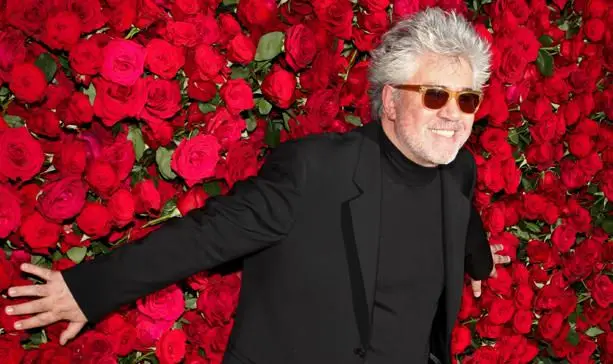
After writing that, I wonder why I chose one of his characters rather than Almodóvar himself as a personal hero, but I did, and these things aren’t logical. ‘Hable Con Ella’, translated as ‘Talk to Her’ in English, is a film that shouldn’t work at all, because both its main female leads spend most of the film in comas. One was a dancer who was injured in a car accident, and the other was a female bullfighter, who lost a bullfight in a most unpleasant way. They are both in a clinic that specialises in looking after coma patients. The dancer is attended by a somewhat creepy male nurse who treats her as if she can recognise everything he says to her and does to her. The bullfighter has a partner called Marco, played by Italian actor Dario Grandinetti.
He was that sort of man
I found Marco to be a fascinating character. He was an Argentinian travel writer. He lived for months at a time in different countries, compiling his notes for his travel books. He interviewed Lydia, the bullfighter, and they became a couple, and he killed a snake in her house after discovering she had a snake phobia, which she shared with his previous partner. He was that sort of man. He loved Lydia, and after she was gored,  he spent a lot of time at the clinic, sitting with her, and he became friends with Benigno, the nurse, who reveals that he loves Alicia, the comatose dancer. So we have two men, who both love women in comas. It doesn’t sound promising as a concept, I admit.
he spent a lot of time at the clinic, sitting with her, and he became friends with Benigno, the nurse, who reveals that he loves Alicia, the comatose dancer. So we have two men, who both love women in comas. It doesn’t sound promising as a concept, I admit.
Marco feels that Lydia is too damaged to survive, and she’s just waiting to die, but Benigno feels that Alicia will wake up one day and resume her life. Marco keeps coming back because he feels responsibility for Lydia. He is constant in his care for her. Events and circumstances cause Marco to leave the country and take up his travel writing again, which should be the end of the story. But he’s brought back by a newspaper article he finds. And he is equally constant in his friendship with Benigno, even though Benigno is in terrible disgrace through his actions. Sorry, I can’t reveal spoilers. You have to watch the film.
Something about him that I immediately liked and admired
Atticus Finch is an obvious role model, because he’s clearly written and described, and he has striking qualities that are highlighted by the story and his role in it. Marcus is not so clear, but there’s something about him that I immediately liked and admired. He is cool, and quiet, and still, and he gives proper attention to those around him, and he understands that we make commitments to people which we must fulfil, no matter what that person has done or what happens to them. I like that. He also has great personal style. I’m a bit of a Marco fanboy, I have to admit.
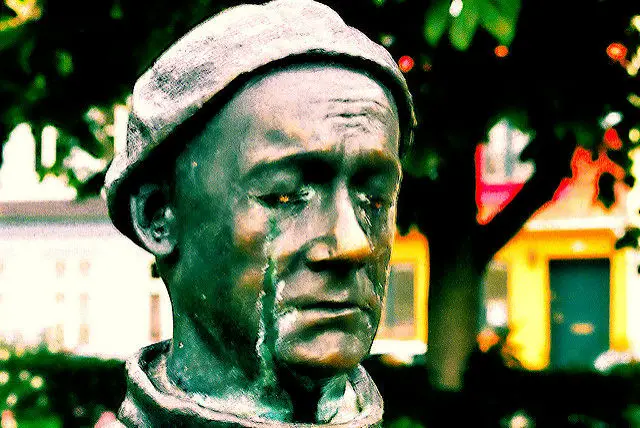
The film is controversial, and deals with difficult subjects, but it’s very clear on the way men love women, and on true friendship and constancy. And it’s not an easy watch. But it also introduced me to the magical dances of Pina Bausch, of whom I became a huge fan too, and the ending is worth all that comes before. I only ever experienced ‘bursting into tears’ once in my life, and it was at the end of this film when I watched it for the first time. Tears actually splashed onto the inside of the lenses of my glasses as they spurted out of my eyes. It was one of the most intense moments of my whole life.
It’s one of the mysteries of being human, and it’s beautiful
We all have heroes, and it doesn’t matter who they are or what we admire about them, or even whether we know why they’re our heroes. They don’t need to be real, and the things we think we know about them don’t even need to have happened. There’s some sort of connection that happens, that becomes significant, and that stays with us for the rest of our lives. It’s part of becoming ourselves, and it happens to all of us, whether we know it’s happening or understand it on any level. It’s one of the mysteries of being human, and it’s beautiful. I wonder who your heroes are.

But if you admire Saint George, may your team be courageous and victorious.
If you have been, thank you for reading this.
Image: Public Domain via Web Gallery of Art under CC BY 2.0
Image: Peter Thwaite under CC BY 2.0
Image: Basher Eyre under CC BY 2.0
Image: public domain under CC BY 2.0
Image: public domain under CC BY 2.0
Image: divine decor under CC BY 2.0
Image: Mario McPherson under CC BY 2.0
Image: a_t_ljungberg under CC BY 2.0
Image: Zulfinho under CC BY 2.0

